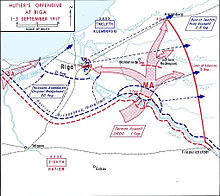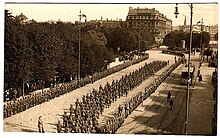Battle of Riga (1917)
Eastern Front (1914-1918)
1914
East Prussian operation ( Stallupönen , Gumbinnen , Tannenberg , Masurian Lakes ) - Galicia ( Kraśnik , Komarów , Gnila Lipa , Lemberg ,
Rawa Ruska ) - Przemyśl - Vistula - Krakow - Łódź - Limanowa - Lapanow - Carpathians
1915
Humin - Mazury - Zwinin - Przasnysz - Gorlice-Tarnów - Bug Offensive - Narew Offensive - Great Retreat - Novogeorgiewsk - Rovno - Swenziany Offensive
1916
Lake Narach - Brusilov offensive - Baranovichi offensive
1917
Aa - Kerensky offensive ( Zborów ) - Tarnopol offensive - Riga - Albion company
1918
Operation Punch
The Battle of Riga took place from September 1st to 5th, 1917 on the Eastern Front of World War I and led to the capture of Riga by the German 8th Army .
prehistory
After defending against the Russian Kerensky offensive in July 1917, the German First Quartermaster General Erich Ludendorff planned an offensive on the Eastern Front that was intended to directly threaten the seat of the provisional government in Petrograd that had emerged after the February Revolution in 1917 and to accelerate the defeat of Russia. The largely evacuated Riga, the capital of the Livonia Governorate at the mouth of the Daugava with a pre-war population of 475,000, formed the northern cornerstone of the Eastern Front and served the Russian army as a stop that stopped the German advance on Petrograd. The Russian 12th Army under General Dmitri Pawlowitsch Parski had its headquarters here. In addition, the Russian army had a bridgehead over the Daugava in more remote than 100km Jakobstadt ( Jēkabpils ). At the beginning of August 1917, the commander-in-chief of the German 8th Army, General Oskar von Hutier , was commissioned to work out a plan for the capture of Riga. For this purpose, three general commands that became vacant after the battle in Galicia was made available to him. The Russian troops had already withdrawn from part of their bridgehead near Riga in mid-August in anticipation of an attack.
course
After strong artillery preparation , led by Lieutenant Colonel Georg Bruchmüller , the battle began shortly after 9 a.m. on September 1st with the crossing over the Düna in the Uexküll area , about 30 kilometers upstream from Riga. The 19th Reserve Division and the 202nd and 203rd Infantry Divisions had been selected for the initial transition . At 2:30 p.m., three pontoon bridges were completed over the Daugava, over which the following troops could reach the opposite bank. By evening the middle of the three breakthrough divisions, the 14th royal Bavarian , had reached the Kleine Jägel after the Russian army withdrew in disarray. For the further advance three German groups were formed: the western one under General Riemann ( VI Army Corps ) was to approach Riga from the east, the middle one under General von Berrer ( General Command 51 ) was to advance north to cut off the Russians' retreat , and the eastern one under General von Kathen ( XXIII Reserve Corps ) shield the advance to the east.
On September 2, the Russian army, withdrawing from the Riga bridgehead, offered considerable resistance, which could not be broken until the afternoon at the Kleine Jägel. During the night the 14th Bavarian Division reached the Große Jägel . Meanwhile, the German troops lying in front of Riga had followed the retreating Russians and were planning an assault on the fortifications for the next day. The heavy fighting continued on September 3rd, with the 2nd Guard Division taking over the eastern part of Riga without a fight in the evening. From the west, the 1st Reserve Division , combined with troops from General Command 60, occupied the city.
On the night of September 4, a Russian radio message was intercepted containing details of the Russian departure. On September 4, the 20th division of the Berrer group succeeded in blocking the road and railway line to Wenden at the level of the Hinzenberg station . To the left of her the 1st Guard Division reached the Livonian Aa as they proceeded . On September 5, the fighting subsided. The Russian 12th Army was in full retreat and the 8th Army dug in for defense after securing the positions it had reached.
Losses and consequences
The loot of the 8th Army amounted to almost 9,000 prisoners and over 260 guns. She was denied greater success by the timely Russian withdrawal. Their own losses amounted to 4,200 men.
As hoped, the successful enterprise accelerated the collapse of the fragile Russian government. The Kornilov affair destroyed trust between the army and Kerensky's government . The company against Riga was soon joined by equally successful companies against Jakobstadt (September 21-22) and against the Baltic Islands ( Albion company , October 12-21). The little later held October Revolution in Russia led in December 1917 to a truce on the Eastern Front, which allowed the German army on the Western Front for the decision examined in spring 1918 spring offensive move. Here - with the participation of Hutier - the tactics tried and tested at Riga were used on a larger scale.
Trivia
Karl Hagen composed a march for the entry into Riga , to which the victorious troops parade in front of the emperor on September 6, 1917.
literature
- Reichsarchiv (Ed.): The World War 1914 to 1918. The conduct of the war in the summer and autumn of 1917. The events outside the Western Front up to November 1918. 1942 ( online ).

